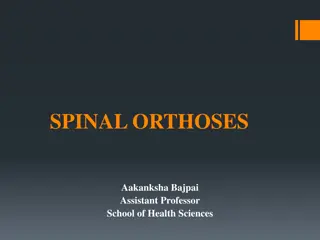Podiatrist's Role in Managing Foot Involvement in Rheumatic Diseases
Rheumatology encompasses over 200 conditions affecting the musculoskeletal system, with foot involvement being significant in conditions like RA and OA. Podiatrists play a crucial role in diagnosing, treating, and preventing foot problems associated with inflammatory arthritis, such as joint damage,
0 views • 20 slides
Innovative Hand Orthosis Development for Duchenne Muscular Dystrophy Patients
Develop an intuitive hand orthosis to support individuals with Duchenne Muscular Dystrophy (DMD). The project aims to enhance active hand support through high-tech, multi-DOF orthoses designed by a team of researchers focusing on control strategies, functional development, and integration with exist
0 views • 9 slides
Understanding Spinal Orthoses: Types, Uses, and Benefits
Spinal orthoses are back braces used to treat spinal disorders and injuries. They provide support, limit movement, and aid in healing. Orthoses are prescribed to realign the spine, immobilize it, limit mobility, and support weakened areas. Various types of orthoses are available based on the segment
0 views • 38 slides
New Foot Orthoses Break-In Best Practices for Optimal Function
Properly prescribed new foot orthoses can improve foot function, leading to changes in foot muscles, leg position, and overall comfort. To ensure a smooth transition, it is important to follow a gradual break-in process, wearing the orthoses for increasing durations each day and monitoring for any s
0 views • 11 slides
Foot Orthoses for Treatment of Patellofemoral Joint Pain
Foot orthoses are custom-designed devices used in treating patellofemoral joint pain by correcting foot posture and improving lower limb biomechanics. They are prescribed as part of conservative management to reduce pain during activities like walking, running, and squatting. Physiotherapists often
0 views • 20 slides
Understanding Orthoses: Types, Indications, Mechanisms, and Effects
Orthoses are mechanical devices used to support, stabilize, and protect various body parts. They can be categorized into different types such as cervical, cervicothoracic, thoracolumbosacral, lumbosacral, and sacroiliac orthoses. Indications for spinal orthotics include stabilizing the spine after a
0 views • 34 slides





